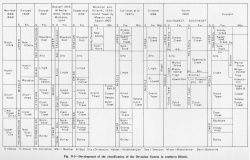Lower Devonian Series
Chronostratigraphy: Paleozoic Erathem >>Devonian System >>Lower Devonian Series
Allostratigraphy: Tippecanoe Sequence
Primary source
Willman, H. B., Elwood Atherton, T. C. Buschbach, Charles Collinson, John C. Frye, M. E. Hopkins, Jerry A. Lineback, and Jack A. Simon, 1975, Handbook of Illinois Stratigraphy: Illinois State Geological Survey Bulletin 95, 261 p.
Contributing author(s)
Charles Collinson and Elwood Atherton
Name
Original description
Lower Devonian Series (Bassett, 1925).
Derivation
The name "Lower Devonian" is generally applied to Devonian strata older than the Onondaga Group of the New York section.
Other names
These rocks have long been called the Lower Devonian Series (Bassett, 1925), although the New York terms "Helderbergian, " "Helderbergian and Oriskanian," and "Ulsterian" have been used at times in Illinois and are still used in other regions (fig. D-5).
History/background
Type section
Type location
Type author(s)
Type status
Reference section
Reference location
Reference author(s)
Reference status
Stratigraphic relationships
As in most of the Mississippi Valley region, Lower Devonian rocks in Illinois are largely siliceous-- cherty, silty limestone and dolomite, and chert formations. They may have originally extended over all of Illinois, unless the Sangamon Arch and the positive areas bordering Illinois were above sea level during this epoch. South of the Silurian reefs, Lower Devonian strata are successively truncated by the unconformity. Along the western edge of the state, the Lower Devonian strata are truncated by the present surface on the flanks of the Ozark Uplift, and they are well exposed in Jackson, Union, and Alexander Counties (Weller, 1944a; Weller and Ekblaw, 1940; Pryor and Ross, 1962).
The Lower Devonian Series includes the Bailey Limestone (siliceous and cherty) at the base, the Grassy Knob Chert, the Backbone Limestone (pure), and the Clear Creek Chert (fig. D-9). The Bailey grades downward into the shale at the top of the Silurian Moccasin Springs Formation. Fossils are scarce in the Bailey, but the few conodonts found there suggest that the base of the Lower Devonian Series is within the lower part of the Bailey (Collinson et al., 1967a).
Extent and thickness
In Illinois the Lower Devonian underlies the southern third of the state, thickening southward from its northern boundary to 1200 feet in the extreme south (fig. D-8). Near the northern boundary the Lower Devonian rocks surround and partially overlap middle Silurian reefs, north of which they are truncated by the sub-Kaskaskia unconformity.
Lithology
Core(s)
Photograph(s)
Contacts
Well log characteristics
Fossils
Age and correlation
Lower Devonian strata are correlated with Emsian and older strata of Europe (Collinson et al., 1967a).
Environments of deposition
Economic importance
Remarks
References
BASSETT, C. F. , 1925, Devonian strata of the Alto Pass Quadrangle: Illinois Academy of Science Transactions, v. 18, p. 360-368.
COLLINSON, CHARLES, L. E. BECKER, G. W. JAMES, J. W. KOENIG, and D. H. SWANN, 1967a, Illinois Basin, in International symposium on the Devonian System: Alberta Society of Petroleum Geologists, v. 1, p. 940-962; Illinois State Geological Survey Reprint 1968-G.
PRYOR, W. A., and C. A. ROSS, 1962, Geology of the Illinois parts of the Cairo, La Center, and Thebes Quadrangles: Illinois State Geological Survey Circular 332, 39 p.
WELLER, J. M., 1944a, Devonian System in southern Illinois: Illinois State Geological Survey Bulletin 68, p. 89-102.
WELLER, J. M., and G. E. EKBLAW, 1940, Preliminary geologic map of parts of the Alto Pass, Jonesboro, and Thebes Quadrangles, Union, Alexander, and Jackson Counties: Illinois State Geological Survey Report of Investigations 70, 26 p.
ISGS Codes
| Stratigraphic Code | Geo Unit Designation |
|---|---|


